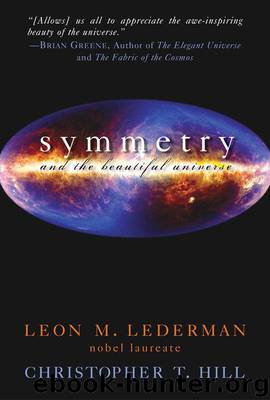Symmetry and the Beautiful Universe by Lederman Leon M. & Hill Christopher T

Author:Lederman, Leon M. & Hill, Christopher T. [Lederman, Leon M.]
Language: eng
Format: azw3
ISBN: 9781615920419
Publisher: Prometheus Books
Published: 2011-11-28T16:00:00+00:00
TIME REVERSAL INVARIANCE AND ANTIMATTER
One of the most remarkable consequences of Einstein’s special theory of relativity is that, when combined with the quantum theory, it predicts the existence of antimatter. The theoretical prediction of antimatter, by Paul Dirac in 1926, and its later experimental confirmation, is one of the most profound scientific results of the twentieth century. We’ll see why antimatter must exist and study it in greater detail in chapter 10. It essentially comes from the discrete symmetries of space and time; hence, antimatter is intimately related to the symmetries of parity and time reversal of space and time. In fact, Richard P. Feynman gave a novel interpretation in 1949 of an antiparticle as a particle moving “backward in time.”
Hence, for every species of elementary particle in nature there exists a corresponding species of antiparticle. For example, the electron, with its negative electric charge, has an antiparticle called the positron, with a corresponding positive electric charge. The positron has the exact same mass as the electron, and when it collides with an electron the two objects disappear, leaving behind photons to conserve the energy and momentum of the collision. At Fermilab we take antimatter for granted, as the Tevatron hurls protons in one direction and collides them head-on with antiprotons hurled in the opposite direction. Such collisions can make a pair of a new form of matter and antimatter, a top quark and an anti–top quark.
The existence of antimatter leads us to yet another discrete symmetry in nature: that of replacing all particles with antiparticles in any given reaction. This is called C, or “charge conjugation.” This symmetry would imply that the laws of physics are exactly the same in the antiparticle world as they are in the particle world. For example, antihydrogen, consisting of an antiproton and an antielectron (positron), would have the same properties—for example, energy levels, sizes of the electron (positron) orbitals, decay rates, and spectrum—as does the ordinary hydrogen atom.
We have already noted that mirror symmetry, designated by P for parity, is not a valid symmetry when it comes to processes involving the weak forces. Furthermore, as we have seen, we can define yet another discrete symmetry operation, called “T,” which reverses the flow of time; that is, we can replace t with –t in all of our physics equations, swap initial conditions with final ones, and get the same, consistent results.
If C is a symmetry of physics, then an antiparticle must behave in every respect identically to its particle counterpart, provided we replace every particle with its antiparticle in any given process. But this makes no reference to the spins and momenta of the particles, which have to do with space and reflection (P) transformations. In the pion decay, π− " μ− + , the produced muon always has negative helicity. If we perform a C operation on this process we get the antiparticle process, π− " μ+ + v0, where all particles are now replaced by antiparticles, but the spins and momenta all stay the same as in the original process.
Download
This site does not store any files on its server. We only index and link to content provided by other sites. Please contact the content providers to delete copyright contents if any and email us, we'll remove relevant links or contents immediately.
The Complete Stick Figure Physics Tutorials by Allen Sarah(7337)
Secrets of Antigravity Propulsion: Tesla, UFOs, and Classified Aerospace Technology by Ph.D. Paul A. Laviolette(5332)
Thing Explainer by Randall Munroe(3909)
The River of Consciousness by Oliver Sacks(3572)
The Order of Time by Carlo Rovelli(3162)
How To by Randall Munroe(3074)
A Brief History of Time by Stephen Hawking(2991)
I Live in the Future & Here's How It Works by Nick Bilton(2960)
What If?: Serious Scientific Answers to Absurd Hypothetical Questions by Randall Munroe(2667)
The Great Unknown by Marcus du Sautoy(2662)
Midnight in Chernobyl by Adam Higginbotham(2515)
Blockchain: Ultimate Step By Step Guide To Understanding Blockchain Technology, Bitcoin Creation, and the future of Money (Novice to Expert) by Keizer Söze(2467)
Networks: An Introduction by Newman Mark(2382)
The Meaning of it All by Richard Feynman(2318)
Easy Electronics by Charles Platt(2308)
The Tao of Physics by Fritjof Capra(2247)
Midnight in Chernobyl: The Untold Story of the World's Greatest Nuclear Disaster by Adam Higginbotham(2195)
When by Daniel H Pink(2098)
Introducing Relativity by Bruce Bassett(2097)
